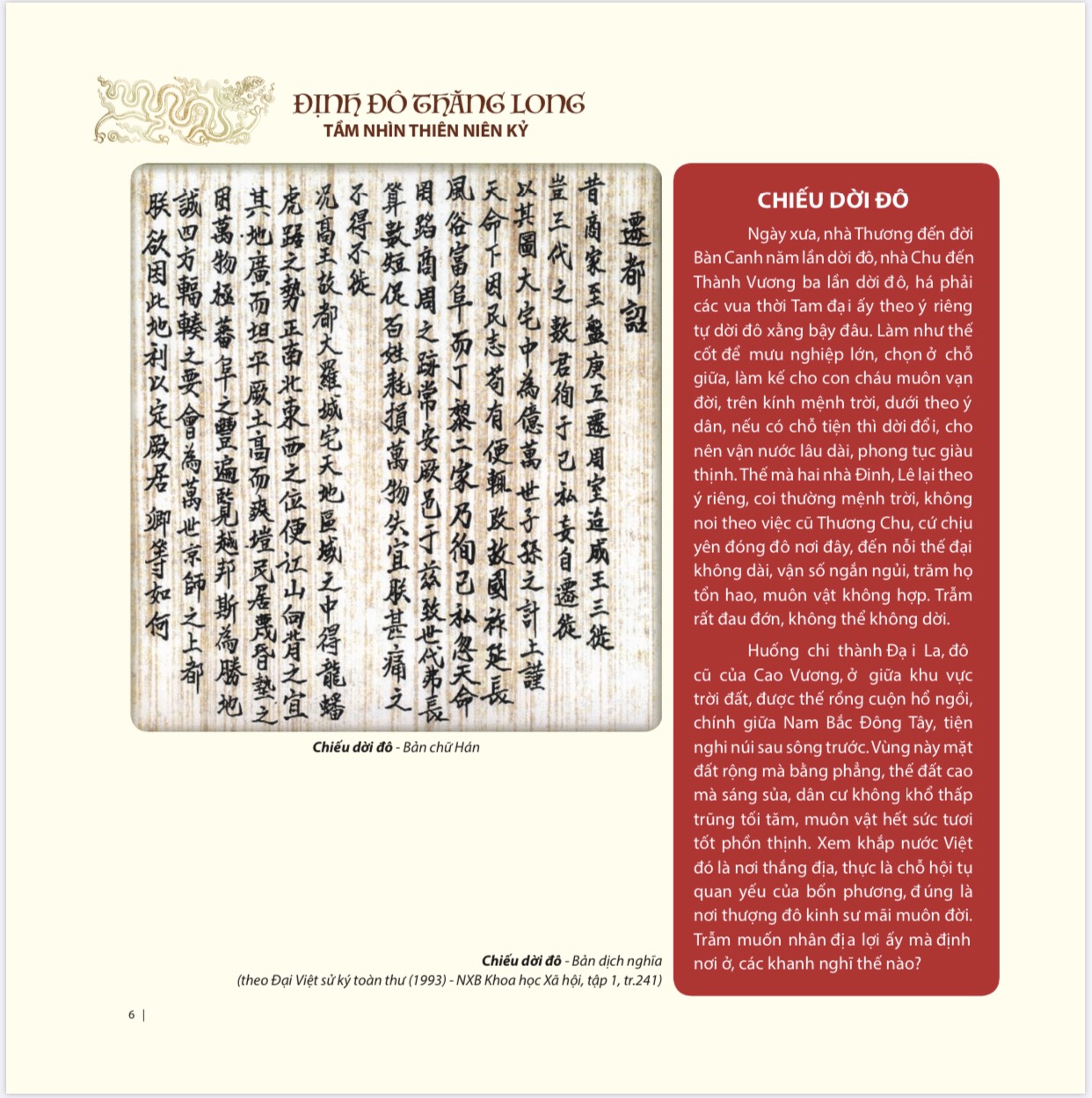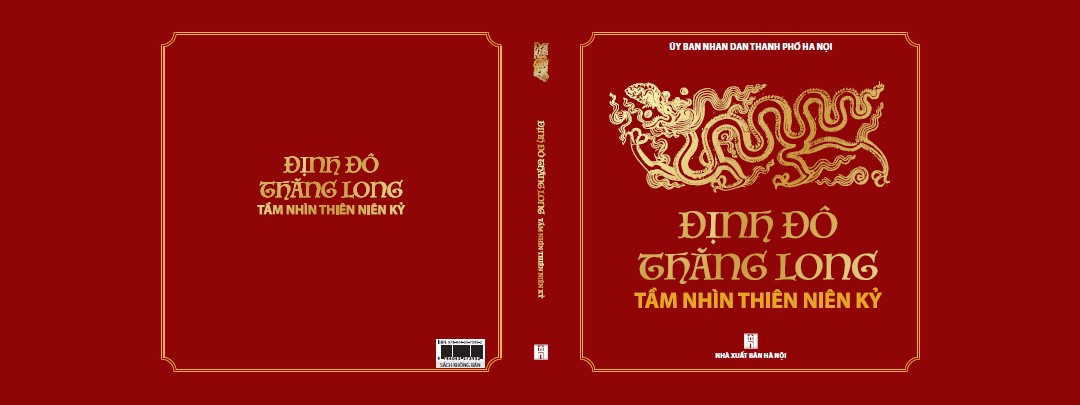

According to Dr. Bui Van Tuan, Deputy Director of the Center for Hanoi Studies and Capital Development, and Secretary of the Editorial Board, he shared some information and the significance of the book's publication: The book was published to present an overview of the establishment of Thang Long as the capital and the appearance of Thang Long - Hanoi from the Ly, Tran, and Le dynasties to the Ho Chi Minh era, when Hanoi became the capital of the Socialist Republic of Vietnam.
What is special about the book "Establishing Thang Long as the Capital - A Millennium Vision"?
In early autumn of the year Canh Tuat (1010), just over half a year after ascending the throne and establishing the Ly Dynasty, realizing that "Hoa Lu citadel was damp and cramped, unsuitable as a royal residence," Ly Thai To devoted himself to studying the classics, learning from the experiences of his ancestors and ancient Eastern nations, and conducting extensive investigations and surveys to correctly understand and assess the position of each locality in the overall strategy of national construction and development. He then made the absolutely correct decision to move the capital from Hoa Lu to Thang Long. The ultimate purpose of this momentous historical decision was clearly and transparently explained by Ly Thai To in the Edict on Moving the Capital: "The main purpose is to pursue a great cause, choosing a central location to plan for future generations, respecting the will of Heaven above and following the will of the people below. If there is a convenient place, then move, so that the nation's fortune will last long and customs will prosper." Although he emphatically asserted that the area of Dai La (later renamed Thang Long) was "a strategically important location, a crucial meeting point of the four directions, truly the ideal capital for all eternity," Ly Thai To still staked his entire career on "heaven's will" and "the people's will," organizing a widespread referendum and receiving the wholehearted support of the people. This was the greatest and most important resource that helped Ly Thai To achieve his miracle in July of the autumn of the year Canh Tuat (approximately from August 13 to September 10, 1010).

On August 1, 2010, coinciding with the 1000th anniversary of Ly Thai To's relocation of the capital from Hoa Lu to Thang Long, the Thang Long Imperial Citadel was recognized by UNESCO as a World Cultural Heritage site because it "reflects a continuous historical series of dynasties that ruled Vietnam in terms of ideology, politics, administration, law, economics, and culture for nearly a thousand years" and because it is rare to find another heritage site in the world that "demonstrates such a long-term continuity of political and cultural development."
Also on this occasion, looking back after 1000 years, the State-level scientific programs on researching and promoting natural, economic, social conditions and historical and cultural values to serve the comprehensive development of the Capital; the Thang Long Millennium Cultural Heritage Book Collection; the Hanoi Encyclopedia; and the International Scientific Conference on Sustainable Development of Hanoi Capital, along with hundreds of research topics and projects of a concluding nature… all affirm that the brilliant development of the Capital, a land of culture, heroism, peace, and friendship over the past 10 centuries, almost all began with or were related to the establishment of Thang Long by Ly Thai To. Ly Thai To's vision and achievements transcended space and time, truly becoming a millennium vision and achievement.
This year, 2020, marks the 1010th anniversary of Ly Thai To's establishment of Thang Long as the capital. We, a group of experts from the scientific program commemorating the 1000th anniversary of Thang Long - Hanoi, have the opportunity to discuss, review, and evaluate research results from the past 10 years and update new research achievements from the last 10 years, in order to complete the book "Establishing Thang Long as the Capital - A Millennium Vision."
Can readers get a brief overview of this book?
The book is divided into 10 chapters (we intentionally emphasize the number 10, which is very significant at this time: the year 1010; the 1010th anniversary; the 10th of October; and the 10th anniversary after the grand celebration), presenting an overview of the establishment of Thang Long as the capital and the appearance of Thang Long - Hanoi from the Ly, Tran, and Le dynasties to the Ho Chi Minh era when Hanoi became the capital of the Democratic Republic of Vietnam and the Socialist Republic of Vietnam. In fact, each chapter could be presented as a separate monograph, but here the authors wish to combine them and reach a wide readership, striving to present the specialized topics and in-depth content in the simplest and most concise way possible.
Chapter I: Ly Thai To and the Establishment of Thang Long as the Capital: This is the introductory chapter, outlining Ly Thai To's founding of the Ly Dynasty, which ushered in a period of comprehensive national revival, implementing domestic and foreign policies that were both in line with the immediate needs of national development and "planned for future generations." Ly Thai To's decision to move the capital and establish a new capital in Thang Long was a momentous event, laying the foundation for the remarkable development of the Ly Dynasty and the Dai Viet nation, ushering in a glorious era in Vietnamese history. "Responding to the will of Heaven, pleasing the people, and seizing the opportune moment," Ly Thai To became the greatest emperor in Vietnamese history, possessing a vision and achievements spanning millennia.
Chapter II: Thang Long Capital during the Ly Dynasty: Chapter II describes the appearance of Thang Long capital during the Ly Dynasty, consisting of three concentric walls, with the Forbidden City and the Dragon City inside serving as the central hub of the dynasty. This was a collection of hundreds of magnificent and opulent palaces, temples, pagodas, and towers, primarily Buddhist architecture and structures in the Buddhist style. Here, the relationship between the court and the common people, between the city and the countryside, and between the economy and culture occurred frequently, directly, and strongly, quickly making Thang Long the largest political, economic, and cultural center, with the strongest influence and reach, elevating Thang Long to a representative city in all aspects of the Dai Viet nation.
Chapter III: Thang Long Capital during the Tran Dynasty: This chapter focuses on clarifying the establishment, planning, construction, and management of the Thang Long capital by the Tran dynasty; and the economic and cultural life of Thang Long during the Tran dynasty. This section also expands to include Dong Do - Dong Quan during the Ho Dynasty and the Ming Dynasty.
Chapter IV: Thang Long during the Early Le Dynasty: Chapter IV clarified the planning of the capital city of Thang Long during the Early Le Dynasty as a relatively common model in East Asian countries. Through the description of the streets and residential areas, it can be affirmed that, under the Early Le Dynasty, Thang Long continued to strongly attract people from all over the country to settle, produce, trade, and study, creating a city that flourished in many aspects.
Chapter V: Thang Long Capital during the Le Dynasty and Trinh Lords: Chapter V clarifies that Thang Long - Ke Cho during the Le Dynasty and Trinh Lords, followed by Bac Thanh during the Tay Son Dynasty, was a period of more than two centuries full of upheaval and paradoxes in the final stage of a city's transition from the capital of Dai Viet to a regional capital. Overall, these were centuries of both political and ideological decline and economic and cultural development, within a complex and interwoven context.
Chapter VI: Thang Long - Hanoi during the Nguyen Dynasty: Chapter VI affirms that Thang Long - Hanoi, up to the Nguyen Dynasty, had served as the capital of Dai Viet for nearly eight hundred years. While the capital was moved to Phu Xuan - Hue during the Nguyen Dynasty, Thang Long - Hanoi remained the central hub of the Northern Citadel for the first thirty years of the 19th century. Along with these changes, the extensive system of fortifications built over the dynasties was dismantled and replaced with a much smaller citadel. Despite this, the economy, especially commerce and industry, continued to thrive in Thang Long - Hanoi with a high degree of specialization. In cultural life, Thang Long - Hanoi remained a major national center for education and scholarship, as well as for literature, architecture, religion, and beliefs.
Chapter VII: Hanoi - Capital of the French Indochina Federation: Chapter VII clarifies that from the mid-19th century, Hanoi, from a declining feudal city, gradually transformed into a modern metropolis modeled after Western cities. Not only a major economic center, Hanoi also became a hub for the convergence and dissemination of national and contemporary cultural values. Education, along with new intellectual movements, became the foundation and driving force behind the development of this new culture. During this period, Hanoi was the center for the formation, convergence, and dissemination of patriotic and revolutionary movements, culminating in the victory of the General Uprising to seize power in Hanoi in 1945, which opened a new phase of development for the city in particular and the country in general.
Chapter VIII: Hanoi - Capital of the Democratic Republic of Vietnam: Chapter VIII affirmed the immense role of the army and people of Hanoi in a new phase of the city's history, resisting French colonialism and American imperialism to protect the independence and freedom of the Fatherland, preserving the peace and happiness of Hanoi, the heart of the country, the thousand-year-old capital of the heroic Vietnamese nation.
Chapter IX: Hanoi - The Capital of the Socialist Republic of Vietnam: Chapter IX highlighted Hanoi's achievements in the political, economic, cultural, social, and foreign affairs fields during the period of reunification, implementing the country's reform policies, and steadily advancing on the path of industrialization, modernization, and international integration. Hanoi continues to affirm its position as the political, economic, cultural, scientific, and educational center of the country, with the titles of Heroic Capital, City for Peace, Creative City, and a history of 1010 years of civilization.
Chapter X: Hanoi - Capital of Culture, Heroism, Peace, and Friendship: This chapter connects and summarizes the topics and issues raised in the book. On the eve of the third decade of the 21st century, Vietnam in general and Hanoi in particular are facing new historical opportunities and challenges of the digital age and globalization in the context of the Fourth Industrial Revolution. This is the time for the Party, the State, and the people of Vietnam in general, and the leaders and people of Hanoi in particular, to look back and evaluate the achievements gained and look towards the future from the intellectual and humanistic perspective of the thousand-year-old capital, in order to exploit the values of tradition, promote the material and spiritual resources of Thang Long - Hanoi, and create a strong impetus to continue building and developing the capital to a new level.
This book is the result of a collaboration between the Department of Information and Communications, Hanoi Publishing House, the Center for Hanoi Studies and Capital Development, the Institute of Vietnamese Studies and Development Science, and the Vietnam National University, Hanoi. On the occasion of the 1010th anniversary of Ly Thai To establishing Thang Long as the capital, we are pleased to introduce the book "Establishing Thang Long as the Capital - A Millennium Vision" to readers interested in and appreciative of the history and culture of the capital city.
Author:VNU Media - Authors
Newer news
Older news